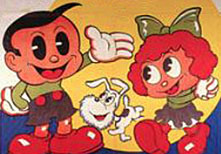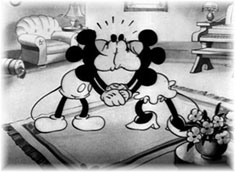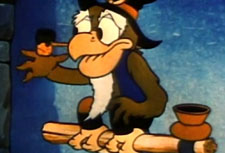
Quick Thunderbean News: Lots in progress – That’s All I’ll Say!
Stories with genuine heart are quite rare in commercial production. Perhaps the success of the Disney films is more related to the audience finding that ‘heart’ more than any other factor. Certainly the other qualities of the films were contributing factors, but the consistency of characters that we can both feel sympathy and empathy for is fairly unique- and missing in any continuous way among all the other studios for the most part, with some exceptions. Snow White, Pinocchio, Dumbo and Bambi carried on this same tradition in the feature films.
 The attempts though are plentiful by the other studios, with varied results. If I’m being honest, these little moments of heart that actually work in other studio’s films are one of the main things that attract me to them. The Mintz Scrappy’s are immediately interesting to me. Scrappy and Oopy, in nearly every cartoon, are portrayed as innocents against a harsh and uncaring world. These qualities nearly leave the series after the departure of Dick Huemer, so it’s clear that both his driving force in gag timing and, with it, character development, made the series what it was. While other qualities make the Krazy Kat series from Mintz good, but ‘heart’ generally isn’t one of those factors.
The attempts though are plentiful by the other studios, with varied results. If I’m being honest, these little moments of heart that actually work in other studio’s films are one of the main things that attract me to them. The Mintz Scrappy’s are immediately interesting to me. Scrappy and Oopy, in nearly every cartoon, are portrayed as innocents against a harsh and uncaring world. These qualities nearly leave the series after the departure of Dick Huemer, so it’s clear that both his driving force in gag timing and, with it, character development, made the series what it was. While other qualities make the Krazy Kat series from Mintz good, but ‘heart’ generally isn’t one of those factors.
The Mickey Mouse cartoons establish these basic character ideas over and over, and the series serves as an example of strong personality-driven character direction being used successfully in different stories. In the Mickeys, it is often the little moments that capture his personality the best, with fast paced gags and destruction of property taking the lion’s share of the action. Perhaps more things are destroyed in 30s Mickey Mouse cartoons than in any other series, with Fleischer’s Popeye as a close second.
 Speaking of Popeye, the heart in the Flesicehr series is a wonderful translation of the much gruffer heart that appears in Segar’s original comic strip. After the first year and a half or so of Popeye cartoons, the character starts to get noticeably more empathetic and gentler, with guidance in both story and voice characterization (by Jack Mercer of course). Mercer (as Popeye) and Disney (as Mickey) both have a unique role in greatly helping to create characters that have genuine care for others as a driving force of their existence.
Speaking of Popeye, the heart in the Flesicehr series is a wonderful translation of the much gruffer heart that appears in Segar’s original comic strip. After the first year and a half or so of Popeye cartoons, the character starts to get noticeably more empathetic and gentler, with guidance in both story and voice characterization (by Jack Mercer of course). Mercer (as Popeye) and Disney (as Mickey) both have a unique role in greatly helping to create characters that have genuine care for others as a driving force of their existence.
The attempts to have aspects of these qualities in other series from various studios through the 30s are fascinating. They usually get one thing right, only to be undone by other factors. While Disney often manages to hit the mark in the Silly Symphonies, the Fleischer’s attempts in the Color Classics almost never do, or somehow misfire in consistency. Song of the Birds (1934) perhaps tries harder than any of the other cartoons in the Color Classic series, and fails to ever make the little boy a character we care about. I think it succeeds in making us care about the birds though, and the ‘death’ scene of the baby is especially haunting in action, music and design. Harman/Ising’s animation perhaps comes closest to the same possibilities in character acting, but often misses badly in storytelling. Bottles (1936) has great design and story ideas that seem to lend themselves to having a more heartfelt connection to the characters, but missing in acting and, ultimately, story work.
Chuck Jones’ later work at Warner Brothers, and of course Hanna/Barbara’s Tom and Jerry shorts capture some of the same heartfelt ideas in story and character acting, but often gag cartoons could survive quite well on funny timing and story ideas without strong character development ideas. The Lantz shorts sadly seem to never have these particular qualities, but I love many of them for other reasons!
 It’s clear that Burt Gillett had learned some of these lessons in story work, and attempted to bring them to Van Beuren’s cartoons. Parrotville Old Folks (1935) is one of the few examples of truly genuine heart in this series, and is wonderfully sweet in its execution. It’s always been a favorite of mine in a series, and, since I’m working on this project right now, is one that I wish 35mm would show up on sooner than later for the upcoming Rainbow Parades Blu-ray. If anyone knows of a source in 35 on this title, it’s the right time to say so! Please!
It’s clear that Burt Gillett had learned some of these lessons in story work, and attempted to bring them to Van Beuren’s cartoons. Parrotville Old Folks (1935) is one of the few examples of truly genuine heart in this series, and is wonderfully sweet in its execution. It’s always been a favorite of mine in a series, and, since I’m working on this project right now, is one that I wish 35mm would show up on sooner than later for the upcoming Rainbow Parades Blu-ray. If anyone knows of a source in 35 on this title, it’s the right time to say so! Please!
Here is the standard definition version of the film from the Thunderbean DVD of the first half of the Rainbow Parade series. I’ll reserve my comments for now, and ask you to try to look at this unusually written short with an eye toward character development and interaction- I’d love to see people’s thoughts about those aspects of the film.
Have a good week everyone!


 Steve Stanchfield is an animator, educator and film archivist. He runs Thunderbean Animation, an animation studio in Ann Arbor, Michigan and has compiled over a dozen archival animation DVD collections devoted to such subjects at Private Snafu, The Little King and the infamous Cubby Bear. Steve is also a professor at the College for Creative Studies in Detroit.
Steve Stanchfield is an animator, educator and film archivist. He runs Thunderbean Animation, an animation studio in Ann Arbor, Michigan and has compiled over a dozen archival animation DVD collections devoted to such subjects at Private Snafu, The Little King and the infamous Cubby Bear. Steve is also a professor at the College for Creative Studies in Detroit.






















To me, “HAWAIIAN BIRDS” from the Fleischer Studio also tries to have some kind of heart as we follow the little female bird to what she thinks is going to be fame and fortune, but I guess, to most people, that whole series tries too hard to be Disney without realizing that the normal Fleischer style can show a sense of urban heart.
They’d forgotten how much we liked POPEYE in cartoons like “LET’S CELEBRAKE”; and, oh, did Hugh Harman try hard enough in cartoons like “THE FIELD MOUSE”, “THE LITTLE MOLE” or “THE HUNGRY WOLF”, and even the voice over talent pushed the emotion to the limit. But you so often felt that jab at your side, as if the animators were collectively looking down on those “cute little” Disney type characters. While turning Bosko into a human, Hugh Harman didn’t even try to expand on the character, other than to give him the full animation.
Bosko and Two Pups cartoons were full of sight gags and perhaps rival Mickey Mouse and Popeye in how much real estate and overall scenery can be destroyed in one cartoon! I’d always marveled at why the talents of the MGM studio was never given a chance to write a full length motion picture, because, as I just pointed out, they had the chops, if driven in the proper direction. I think that the Warner Brothers animators did try at times. We kind of feel empathy toward Porky Pig in cartoons like “SHANGHIED SHIPMATES” as he actually leads a mutiny against a cruel (and I mean *CRUEL*) captain, but most of the 1930’s output at the studio is more geared to music and gag content in time to that music.
Thanks for this cartoon, though. I wished that Van Buren did more with Felix the Cat. They gave him a good voice, but very little to do as representation of who or what he is. He could have been replaced by just about any other creature you can name, but I do like the three FELIX entries. I just like 1930’s cartoons for the surreal chances they take.
Glad you mentioned HAWAIIAN BIRDS, Kevin. I was at a screening of some classic live action films less than two weeks ago and someone decided to slip in that cartoon, unannounced. The audience reaction (about eighty, mostly adults) was great… folks were coming up afterwards asking about it!
Even if a studio’s primary output is gag shorts, a little heart wouldn’t hurt once in a while. Tex Avery did just fine with stuff like “I LOVE TO SINGA” and “LITTLE ‘TINKER”.
That said, I don’t like it when attempts at empathy include villains frothing with manic glee over abusing the weak, in the case of the Fleischers’ animal cruelty crusades like “BE KIND TO ‘AMINALS'” and “BE HUMAN”, and Warners’ “SHANGHAIED SHIPMATES” and “PORKY IN THE NORTH WOODS”. Some of that stuff’s actually pretty hard to swallow.
I see the little flames from “Parrotville Fire Department” are getting in on the fun! 😀
Straight away I thought of Tom sitting by the fire and wracked with remorse, in the Night Before Christmas, as one of my favourite examples of heart-strings being plucked like a harp by a cartoon.
Granted, a lot of nostalgia plays into that – especially when, as a kid, I wasn’t so aware of how early in the chronology of the series that short comes – but the idea that Tom & Jerry can so consistently be at each other’s throats and suddenly feel such empathy because it’s Christmas, makes the entire sequence after Jerry dives through the mail-slot a total classic for me.
Without fail, and entirely due to that emotional kick, it used to be the the last thing I watched before bedtime on Christmas Eve – regardless of where or whoever I was with.
I now fully share/inflict that tradition on my two girls every year – and eventually it’s message might even sink in aswell! 😉
Of course the undisputed champ in the “heart” department is when Snow White is dead and Grumpy turns away to cry.
Animavens tend to dismiss the Chuck Jones “Disney cute” Warner Bros. cartoons circa 1940, but “Tom Thumb in Trouble” is in its way quite remarkable. With Popeye, Bluto, and even Gulliver in his stolid way, Fleischer had better success than most (even Disney) with human male characters, which tended to be boys, clowns, villains, dim grandpas (even Gepetto falls under that category), or vaguely effeminate princes. But “T.T. in T.” manages, in Tom’s father, a believably masculine character who’s also gentle and sensitive–even capable of shedding a tear.
Take sweetness and warmth in these cartoons as you can, because that’s the only place you’ll find them anymore. The closest thing we’ve got today is a kind of calculated mawkish sentimentality, and even that’s getting hard to come by since Don Bluth stopped making those features where the characters tell each other to “follow your heart.” And I don’t know about you, but a pencil drawing can make me cry, but a CGI file cannot.
I, too, love good hand drawn full animation much more than digital animation. But if I could do a full inventory I’m pretty sure I’d find a lot of digital animation that tugged at my heart, too. In fact, a recent digitally animated movie had a more emotional moment that I’ve ever had with hand drawn animation: near the end of “Coco” I could only barely stop myself from having a full on, out loud bawling! That was second hardest any movie had ever made me want to cry. (I won’t tell you the movie that made me cry the hardest, but it was live action, not animated.)
What happened to Winston Sharples? His early scores are fine. But by the time he gets to Famous, his scores are shrill and rote.
I’m sure that’s because he ended up in a routine he simply couldn’t break!